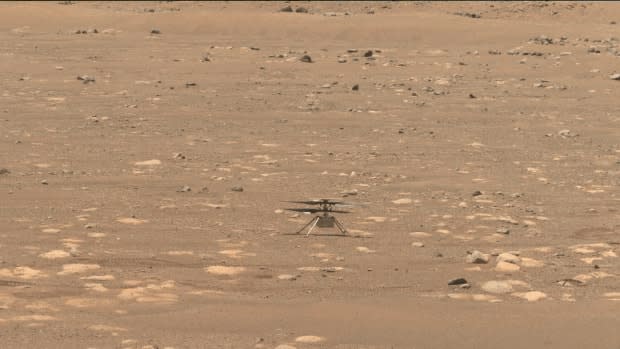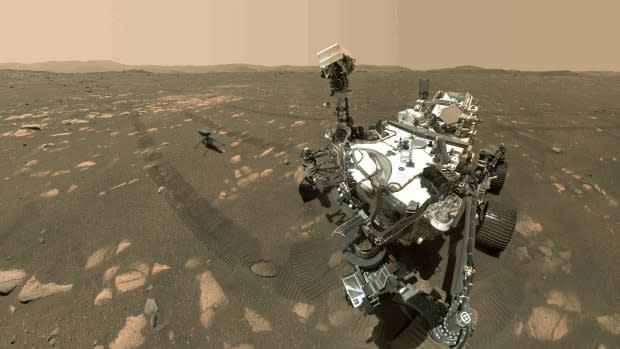NASA prepares for a historic helicopter flight — on Mars

Roughly 278 million kilometres away, a small, 1.8 kilogram helicopter is waiting to take its place in the history books alongside the Wright Brothers.
After an original target flight date of no earlier than April 11, NASA's Ingenuity helicopter will become the first aircraft to fly on another planet no earlier than April 14 as it lifts off the surface of Mars.
The helicopter arrived at Mars on Feb. 18, tucked safely away on the Perseverance rover.
NASA announced that there had been an issue during a test of the rotors late last Friday. As a result, the new target launch date is April 14, though it has not been confirmed, nor has a specific launch time been given.
The flight, while historic, is just the beginning of trying a new way of exploring other worlds. It doesn't have any scientific instruments, but is a test of the first powered, controlled flight outside of Earth.
"On a cool December morning in Kitty Hawk, North Carolina, history was made," said Thomas Zurbuchen, NASA's associate administrator for science in a press conference on Friday.
"It took 12 seconds to make history: the first controlled flight here on Earth and something that had huge consequences.
"We're ready for another historic moment. A historic moment the likes of which have analogues in 1903. A controlled flight on a different planet."
WATCH | NASA's Perseverance rover arrives at Mars:
Flying on Mars isn't anything like flying on Earth. Unlike our planet, Mars has an extremely thin atmosphere, just roughly one per cent that of Earth, which means getting lift requires more effort.
There's also the added challenge of the lower gravity on Mars (one-third that of Earth's) and potentially high winds, as well as trying to keep warm on chilly nights where the temperature dips down to about –90 C.
"Helicopters on Earth — as a reference — can fly, like 3,000 metres, 10,000 feet. And they don't usually fly that high, but it's about their capability," said Jim Reuter, NASA's associate administrator for space technology. "Flying ingenuity on Mars would be comparable to taking that full size helicopter and, instead of flying it 3,000 metres, flying it at 30,000 metres or 100,000 feet. And so Ingenuity has to be extremely light, relatively large [for its weight], and have fast rotor blades."
Last Thursday, Ingenuity successfully tested its pair of 1.2 metre rotor blades briefly at its location in Jezero Crater, slowly so that it did not generate lift.

The maiden flight — the first of four scheduled — will be just like the Wright brothers' first: brief.
Ingenuity will lift off and climb at roughly one metre per second to an altitude of three metres. It will hover for about 30 seconds and then descend at roughly one metre a second. The flight will be captured by two cameras, one a low-resolution camera that sits underneath the body, the second, a 13-megapixel colour camera.
And on that flight will be a part of the Wright Flyer — a piece of muslin from the plane's wings.
"That's attached to just below the solar panel," Reuter said.
"And actually back in 1969, on the Apollo 11 flight, they also brought some of the same material up to the moon and brought it back along with a piece of wood from from the Wright brothers' plane. And so ... [the] Wright Brothers plane has visited both Moon and Mars."
Learning to fly
The team believes they've prepared all they can.
The concept of a helicopter on Mars began in 2014 followed by years of testing in Jet Propulsion Laboratory's (JPL) 7.62-metre-wide vacuum chamber, where all spacecraft are tested, including the Voyager spacecraft that toured our outer planets in the late 1970s and '80s.
For the Mars helicopter, a vacuum was created where all the nitrogen, oxygen and other gases were sucked out. Then carbon dioxide — which is the main ingredient of Mars' atmosphere — was pumped in. The first test experienced a "rapid unscheduled disassembly," or engineer-speak for a crash.
But from that and other tests, the team learned that things happen too quickly in a Martian environment for humans to react to, especially when the time delay between Earth and Mars is taken into account. They realized that the helicopter needed to fly on its own, which it will do on Sunday after receiving a flight profile.
Using powered aircraft on other worlds is a natural progression in space exploration, said Reuter.
"One way I look at it is, we as humans, we learn to crawl, then we learn to walk, then we learn to run. And we've kind of been approaching the exploration of Mars in particular and other planets in a similar way: the first thing is we've gone to orbit, then we learned to land … then we've added increasingly complex rovers," he said.
"Well, now the next natural thing … is to do things that take you longer distances, like flying."

Paving the way for future missions
One particularly ambitious mission that will use powered flight is NASA's Dragonfly mission, scheduled to launch in 2027, that will fly around Saturn's largest moon, Titan.
Unlike Ingenuity, Dragonfly will be a car-sized drone with eight rotors. It will also be a scientific mission looking for either past signs or current signs of prebiotic life on Titan. The moon is similar to Earth in that it has a thick atmosphere, lakes (of methane rather than water) and even weather patterns. Some planetary scientists believe that life unlike any we're familiar with may be able to exist either on or below its surface.
Catherine Neish, an assistant professor at Western University's department of earth sciences, is a co-investigator on the Dragonfly mission who will be keeping up with Ingenuity's performance over the coming weeks, even if it's with a bit of rotorcraft envy.
"I was kind of upset when I heard that Ingenuity was going to fly, because I really wanted Dragonfly to be the first spacecraft to fly on another world," she said laughing. "But despite my annoyance with Ingenuity, I do hope it works well and we're able to fly on more planets in the future."
One possibility? Venus.
"There's a lot of interest in potentially sending an aircraft to Venus. Of course, the surface is so hot. It's almost like being at the bottom of a really hot ocean. But there are places within the Venusian atmosphere that are actually very Earth-like," she said. "And I think Venus would be another great place to try out this technology."
While the team analyzes the issue raised ahead of the first test flight, engineers and scientists will be on the edge of their seats waiting.
"It's so exciting," Reuter said. "This has been a great ride already."

 Yahoo Finance
Yahoo Finance 